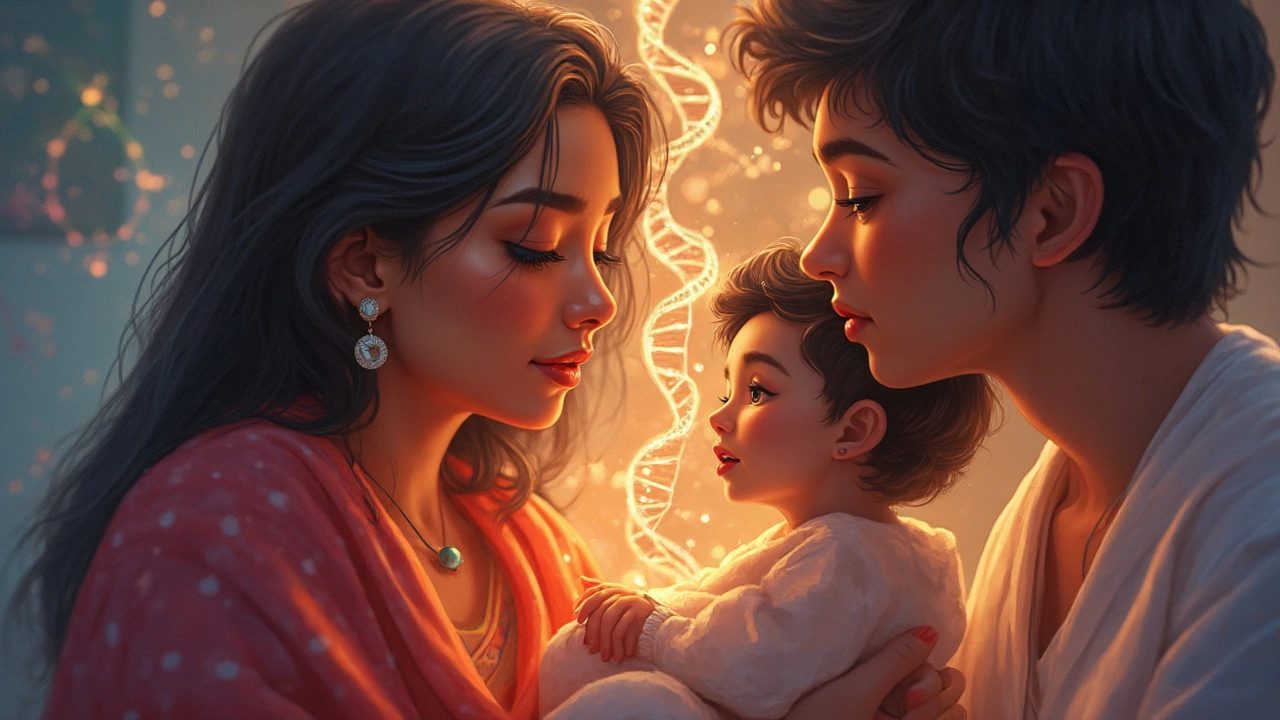There’s this question a lot of parents ask: if a child is born through IVF, do they really have their mom’s DNA? With all the science talk and medical terms thrown around, it’s easy to feel lost. But the answer’s actually pretty simple—if the mother’s egg is used in IVF, the baby absolutely carries her DNA. It works just like it does in natural conception: the egg brings half the DNA, and the sperm brings the other half.
Now, things only get complicated if a donor egg or surrogate is involved. If a woman’s own eggs are used, she’s the genetic mother, plain and simple. But swap in a donor egg, and the DNA comes from the donor, not the woman who gives birth. Mitochondrial DNA (the stuff you inherit only from your mom) sticks with whoever’s egg is used, not the dad or the woman who’s carrying the pregnancy if it’s a surrogacy arrangement. That’s a detail people often miss.
Quick tip? Always ask your IVF doctor to spell out exactly whose DNA will be passed on. Don’t guess—double-check when donor eggs, sperm, or embryos become part of the process. Even some doctors forget to break down these details clearly, especially when parents are overwhelmed with info.
Genetics can feel mysterious, but IVF basics really aren’t, once you cut through the jargon. It’s just about where the egg and sperm come from—everything else is an extra layer. So, if you’re feeling anxious or confused, you’re not alone. Keep reading and I’ll break down how it all fits together, short and simple.
- Clearing Up the Basics: IVF, Eggs, and DNA
- Where the DNA Comes From
- Special Cases: Donor Eggs and Surrogacy
- Tips for Parents Considering IVF
Clearing Up the Basics: IVF, Eggs, and DNA
Alright, let’s break down what’s actually going on in IVF. The whole process is about helping the egg and sperm meet outside the body. The doctors collect eggs from the woman and sperm from her partner (or a donor), then mix them together in a lab. If fertilization works, a doctor puts the resulting embryo into the woman’s uterus. Pretty straightforward, but there’s a lot of confusion about how the baby’s DNA is decided.
Here’s the real deal: the baby’s genetic material comes straight from the egg and the sperm. No matter what high-tech procedure is used, if a woman’s own egg is fertilized by her partner’s sperm, that kid will have DNA from both biological parents. This means the baby will inherit half its genes from the mother and half from the father, just like in regular conception.
You might have heard of mitochondrial DNA too—that’s the tiny portion of DNA in every cell that passes only from the mother (whoever provided the egg). It helps run the cell’s energy, and it’s always from the egg provider, not the dad or even the woman carrying the baby if it’s a surrogacy case.
Here’s a quick recap list:
- If it’s the mom’s own egg: the baby has her DNA.
- If a donor egg is used: the baby gets DNA from the donor, not the mom carrying the pregnancy.
- Mitochondrial DNA comes from the egg, so whoever provides the egg passes this on too.
IVF might sound complicated, but at the core, it all revolves around whose egg and sperm are used. That’s the secret sauce for the baby’s genetic blueprint. Ask your fertility specialist to be clear about where the egg’s coming from—not just for peace of mind, but so everyone’s on the same page about what DNA the baby will have.
Where the DNA Comes From
If you’re going through IVF, here’s how it really works: DNA, or your genetic code, comes from the combination of the egg and sperm. If you’re using your own eggs, your baby has your DNA. If your partner’s sperm is used, their DNA also comes into play. So, when you hear people ask, “Do IVF babies have their mom’s DNA?”—the answer is yes, if mom’s egg is in the mix.
To make this clear, check out this quick breakdown:
- Your egg (contains your DNA): Used in IVF, your child gets your genetics.
- Donor egg (contains donor’s DNA): If you use a donor egg, the baby gets DNA from the donor, not you.
- Your partner’s sperm (contains their DNA): Used in IVF, your child also gets their genetics.
So, the main thing shaping your child’s genes is where the egg and sperm come from. No high-tech IVF step changes this basic rule.
| Egg Source | Sperm Source | Whose DNA? |
|---|---|---|
| Mom | Dad | Mom & Dad |
| Egg Donor | Dad | Donor & Dad |
| Mom | Sperm Donor | Mom & Donor |
| Egg Donor | Sperm Donor | Donor & Donor |
There’s a popular myth that IVF labs “add” or “change” genes, but this isn’t true. IVF just helps sperm meet egg outside the body. Dr. Norbert Gleicher from the Center for Human Reproduction sums it up well:
"IVF, by itself, does not alter the DNA of the sperm or egg involved; it simply creates an opportunity for natural genetics to work in a lab setting."
Remember, if your IVF treatment uses your egg, your DNA is passed down. If a donor is involved, their DNA is. Always ask your clinic about egg and sperm sources—don’t leave anything up in the air.

Special Cases: Donor Eggs and Surrogacy
This is the part where things can get confusing. A lot of people think the woman who carries the baby is always the genetic mom, but that’s not always true when donor eggs or surrogates are in the picture. Here’s how it works.
If an IVF cycle uses a donor egg, the resulting baby gets DNA from the egg donor, not the woman who is pregnant. That means if you use a donor egg and your partner’s sperm, your child’s DNA comes from the donor and your partner. The woman who carries the baby provides the environment—the womb—but not the genetic material. It might feel strange, but it’s simply science.
With surrogacy, there are two types you’ll hear about:
- Gestational Surrogacy: The surrogate carries an embryo made from someone else’s egg and sperm. She’s not the genetic mom. She just provides the uterus and carries the pregnancy to term.
- Traditional Surrogacy: The surrogate uses her own egg and is inseminated with sperm from the intended father or donor. In this case, she is the genetic mother.
Gestational surrogacy is way more common now, especially because people want the parents (not the surrogate) to be the genetic link. More than 95% of surrogacies in the United States are gestational, according to the CDC.
If you’re looking at egg donation, you’ll be asked about using a known donor (maybe a friend or sister) or an anonymous one. Both paths mean the donor is the genetic mother. There’s no medical way around that right now.
Here’s a quick table to show the DNA connection in different scenarios:
| Scenario | Whose DNA? |
|---|---|
| IVF with Own Egg and Sperm | Mom and Dad |
| IVF with Donor Egg | Egg Donor and Dad |
| Gestational Surrogacy (Own Egg/Sperm) | Mom and Dad |
| Gestational Surrogacy (Donor Egg) | Egg Donor and Dad |
| Traditional Surrogacy | Surrogate and Dad |
If you want to be sure about the genetics, the key is knowing exactly whose egg and sperm are used. Doesn't matter if you, your partner, or someone else carries the pregnancy—it's the DNA in the egg and sperm that counts. If you’re planning your own journey, keep this chart handy or snap a screenshot. It saves a lot of awkward and confusing conversations with doctors or even curious relatives.
Tips for Parents Considering IVF
Thinking about IVF can feel overwhelming, but a few simple tips can help make things a lot clearer. You want answers, not just hope. Here’s what will actually help as you start the process.
- Ask direct questions about DNA. If keeping a genetic link matters to you, be super clear with your clinic. Confirm if your own eggs and your partner’s sperm are being used, or if donors are involved. Don’t rely on assumptions or vague info.
- Understand success rates for your age group. The chances of having a baby through IVF drop as you get older. Under 35? You may see live birth rates from one cycle near 50%. Over 40, that number falls dramatically. See the quick numbers below:
| Age Group | IVF Live Birth Rate (%) |
|---|---|
| Under 35 | ~48% |
| 35–37 | ~33% |
| 38–40 | ~22% |
| 41–42 | ~12% |
| Over 42 | ~4% |
- Don’t skip counseling. There are big emotions that come with IVF—stress, excitement, sometimes disappointment. Talking it out with a counselor or support group helps you stay grounded.
- Check how your clinic screens embryos. Some clinics offer genetic testing (PGT-A) to spot chromosome problems early, which can help improve success and lower the risk of certain genetic conditions.
- Costs add up. One IVF cycle in the US runs between $12,000 and $15,000, sometimes more if you use donor eggs or genetic testing. Ask for a price breakdown up-front so there are no surprises.
- Be ready for more than one try. Sometimes IVF works the first time—but not always. Having a backup plan and knowing you may need a second cycle helps keep expectations realistic.
If you're focused on the genetics side, remember: as long as your own egg is used, your IVF baby will absolutely have your IVF DNA. Egg or sperm donation is the only curveball. Make sure you’re on the same page with your clinic before you start, and stay involved every step of the way.

 Pitta Person Traits: What Sets Them Apart in Ayurveda
Pitta Person Traits: What Sets Them Apart in Ayurveda
 How Long Is the Average Stay in Rehab After Knee Replacement?
How Long Is the Average Stay in Rehab After Knee Replacement?
 The Darker Side of IVF: What You Need to Know
The Darker Side of IVF: What You Need to Know
 Affordable IVF Clinics in the United States: Finding the Best Options
Affordable IVF Clinics in the United States: Finding the Best Options
 Is Medical Tourism Safe in Mexico? What You Need to Know Before You Go
Is Medical Tourism Safe in Mexico? What You Need to Know Before You Go